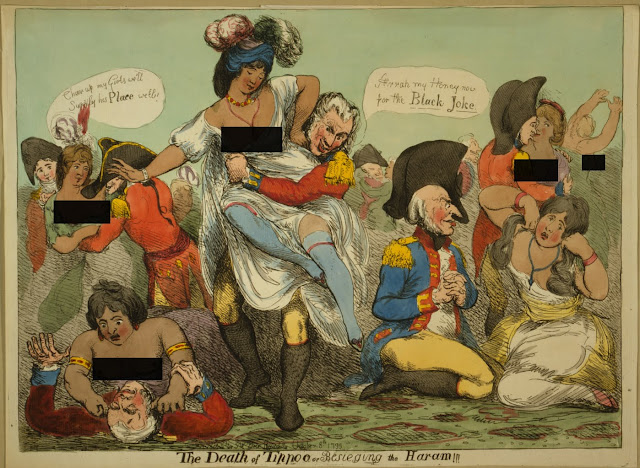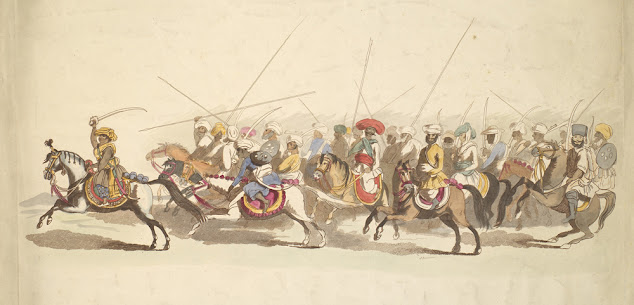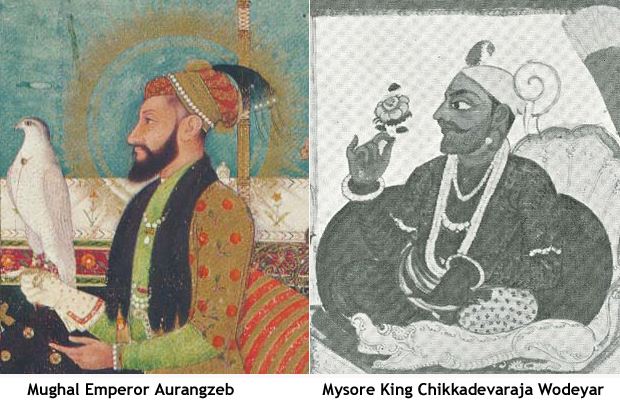Some British atrocities on civilians of south India during Anglo-Mysore Wars
Research and author: Ameen Ahmed
In today's India, the name Tipu Sultan brings with it a shrill debate, each time it is mentioned publicly. Tipu's detractors waste no time and leave no opportunity in highlighting sources, both contemporary and later, that seek to paint him as a bigot. Unfortunately this has, in the past three decades, taken the spotlight away from the purpose of his battles and perhaps his life- to fight the inhuman occupation by a non-native power. The British East India Company was not here in south Asia for a walk in the park. It was here to plunder the sub-continent's resources and take them back to Great Britain. And to achieve this, its soldiers indulged in loot, rape, murder and wanton destruction. The British Governments back then seemed to give a damn about the suffering and deaths of ordinary Indians. In this write-up, I try to highlight some of the miseries caused by British armies on the ordinary civilians of Karnataka (erstwhile Kingdom of Mysore).
Haidar Ali and Tipu Sultan, the father-son rulers of Mysore Kingdom, fended off European colonials for about 40 years in between them in mid-late 18th century. They fought four wars, known as the Anglo - Mysore Wars, against the British East India Company. Tipu took part in each of these wars, while Haidar died mid way through the second.
The British got their first jolt in Peninsular India from a native power, when Mysorean soldiers led by Mukhdoom Saheb under Haidar Ali, defeated Major Moore's detachment on 17th July 1760 near Trivady near present day Pondicherry (2). This was just three years after the Battle of Plassey which resulted in the British getting control of the wealth, rich resources and tax collection of India's province, and one of world's richest regions.
Second Anglo Mysore War (1780-84) - Honnavar, Anandapuram and other massacres
Soldiers committing excesses against civilians during armed conflicts were not uncommon two centuries ago as they are today. That said, intimidation of civilians, particularly women and children, seems to be have been ingrained in the psyche of soldiers of British East India Company during their four decades of conflict with the Kingdom of Mysore. There are many incidents that stand out. In 1783, at the height of the Second Anglo-Mysore War, the British received news of the death of Haidar Ali. The President and Council of the Bombay Government ordered General Mathews to move to Honnavar and encourage the residents to revolt against Tipu's succession of Haidar Ali. When that did not happen they allowed Mathews discretionary powers to act as he deemed wise in the Bednore region (3). Bednore or Haidar Nagar, was then one of the largest and finest cites in India and held immense wealth. The region then, as it is today, held an immense bounty of nature particularly hardwood like teak. As Tipu was busy inheriting the affairs of Mysore Kingdom left behind by his deceased father, General Mathews swept through the region capturing forts like Honnavar (anglicised: Onnore) and Anandapuram (anglicised names: Anantapoor/ Annanpoor/ Hanampoor). But his campaign was characterised by atrocities against civilians and unarmed soldiers and their families. Landing first at Honnavar, he massacred people of all 'ages and sexes'. He proceeded then toward Bidanur (also known as Haidarnagar or Nagara), massacring people all along (4). At one place in between he executed three hundred Mysorean troops after a battle (5). Here's what the Annual Register of 1783 (6), says about this affair:
'It is with pain we recount, that as slaughter, cruelty, rapine, and avarice had disgraced this expedition in its commencement at Onore, so the same detestable maxims and vices, continued to stain its whole progress, until they were, at its fatal conclusion, most cruelly required; when the innocent became indiscriminately with the guilt, victims to the rage of an exasperated and merciless enemy.'
Some of the officers in the campaign wrote private letters to their friends detailing the campaign particularly the atrocities. One officer writes of how Mathews overran unarmed military posts and massacred the captured men. The Annual Register of 1783 (ibid. 6) gives an account of the same officer below:
'The officer, indeed, who gives an account of the massacre at the fortress of Annampore, which was taken by storm, under some preceding circumstance of aggravation on the side of the governor, and from whence only one horseman, desperately wounded, had the fortune to escape the general slaughter, seems to feel no small compunction and horror, in describing the spectacle which was there exhibited, of four hundred beautiful women, all bleeding with the wounds of the bayonet, and either already dead, or expiring in each other's arms; while the common soldiers, casting off all obedience to their officers, were stripping off their jewels, and committing every outrage on their bodies, He says that others of the women, (without taking notice whether their lives were offered or not) rather than to be torn from their relations, threw themselves into large tanks, and were drowned.'
Tipu's retaliation was swift and brutal. Gen. Mathews and his troops were captured, chained and transported to prisons across Mysore Kingdom along with soldiers captured in the Battle of Pollilur (ibid 5).
Tipu also acted against people who are said to have aided the British in these campaigns, chiefly the Catholics of Mangalore.
 |
| Dungeons and living space atop Bangalore Fort. British war criminals who took part in Anandapuram massacre and elsewhere were imprisoned in forts across the Mysore Kingdom. Pic: Ameen Ahmed |
Third Anglo Mysore conflict (1790-92)- The destruction of an industralised kingdom
Contemporary British writings point to Mysore Kingdom being highly industrialised and having high agricultural productivity at the beginning of the Third Anglo Mysore war. Eye-witness accounts come from British soldiers who took part in the war. Major Dirom was one such soldier who wrote this about territories in his book:
'his country was found every where full of inhabitants, and apparently cultivated to the utmost extent of which the soil was-capable; while the discipline and fidelity of his troops in the field, until their last overthrow, were testimonies equally strong, of the excellent regulations which existed in his army. His government, though strict and arbitrary, was the despotism of a politic and able sovereign, who nourished, not oppresses, the subjects who are to be the means of his future aggradizement; and his cruelties were, in general, inflicted only on those whom he considered his enemies.' (8)
Edward Moor, another British soldier who took part in this war also published an eye witness account of the war in 1794. According to him Tipu Sultan had a mechanical mint for his coins which was then unheard of anywhere else in India. (9)
J.M.Matthew, a fellow British officer, in his book published in 1793, wrote on what he saw and heard inside Bangalore fort on 25th March 1791, four days after its capture from Mysorean forces:
'On the works of Bangalore are upwards of one hundred pieces of artillery, many of them brass, and some thirty-two pounders. There is a regular arsenal, a foundary, workshops for every denomination or artists, large yards full of timber, and in short every convenience that can be required in the manufacturing of military implements. There is also a very curious machine, worked by bullocks, that bores 130 musquet barrels at once, and another for boring cannon, both of French construction.' (10)
This war saw some of the worst brutalities against civilians of the Mysore Kingdom. Accounts of Major Dirom, J.M.Matthew, Edward Moor and East India Company commissioned Traveler, Writer and Physician Francis Buchanan (11) give a very gloomy picture of the destruction of civilian and industrial infrastructure, as well as agriculture, at the hands of British and its allies, in particular the Maratha Generals Hari Pant and Parasuram Bahu. If one goes by these sources, women and civilians seem to have been deliberate targets.
Here's what Buchanan wrote about the destruction caused by the invasion of Cornwallis and his allies the Marathas and the Nizam, just over a decade later:
'It is said, that one-fourth of the grain which, in times of plenty, the people usually consume, is sufficient to keep them alive, and enable them to work for their subsistence. It is when war is joined to scarcity, and interrupts the transportation of grain, that famine produced all its horrors. These were never so severely felt here, as during the invasion of Lord Cornwallis; when, the country being attacked on all sides, and penetrated in every direction by hostile armies, or by defending ones little less destructive, one half at least of the inhabitants perished of absolute want'.
General Medows was a part of the siege and capture of Bengaluru Pettah or Pete (city) on 7th Mar 1791. J.M.Matthew wrote that General Medows called his fellow soldiers to 'get' women from the captured town. Medows is said to have expressed himself to the Grenadiers of the Thirty-Sixth Regiment to the following effect: "Now is the time for you, my brave Lads with the whiskers, there are plenty of fine Girls within, and here is a little fellow will presently show you the way to get at them".
Matthew further writes that a number of women and children escaping the siege of Bangalore fort under the cover of darkness were killed, although he adds such deaths were unintentional. After the fall of Bangalore, many of its residents fled south to the village of Thally (anglicised: Tali), which is located in present day Denkanikottai Taluk, Krishnagiri district of Tamil Nadu, but the British soldiers based at nearby Hosur pursued them, looted and burnt that village as well, according to Buchanan.
In mid-October of the same year, Nandi Durga (Nandi Hills) fell to the British. According to Kirmani, an officer of Haidar Ali and later Tipu Sultan and their biographer, 'thousands' of women were raped and many flung themselves from the cliffs to save their honour. (12)
The crimes of Maratha soldiers, who allied with British during this war, have been well documented by British soldiers who took part in the war. J.M.Matthew also documented some atrocities committed by soldiers accompanying Cornwallis, like plundering and burning of villages.
Buchanan documented the following destruction by British armies under Cornwallis during the Third Anglo-Mysore war:
1) Bangalore (Bengaluru): Residents fled to Thalli in 1791 but the British troops from Hosur chased and looted them and burnt the village.
2) Bhidi Caray village near Nandi Hill, north of Bangalore: Desolate due to Cornwallis' invasion.
3) Madhugiri: Suffered.
4) Kolar: Merchants 'suffered' due to invasions of Gen. Mathews & later under Cornwallis.
5) Katte Malawadi village: 'Destroyed' by Cornwallis again, after it was originally destroyed by Peshwa Badji Row in 1771 CE. Most of its inhabitants perished under both invasions.
6) Satyagalu village: 'Destroyed'.
7) Singanaluru village: 'Destroyed'.
8) Hanur village: 500 houses 'destroyed'.
9) All houses between Hanur & Caudhally destroyed by Col. Read's Banjarees & Nizam of Hyderabad's army.
10) Kaveri Pura and surrounding villages: Plundered by Lambanis (anglicised: Lumbanies) accompanying Col. Read.
11) Hulluguru village: Burnt under Cornwallis' command.
12) Kellamangalum: Burnt during Cornwallis' march to SR Patna.
13) Between Sicanay Pura & Muloor: Agriculture destroyed.
14) Ramagiri hill, along Arakavathy river: Many civilians here died during Cornwallis' campaign.
Fourth Anglo-Mysore War (1799)- The final plunder
This war was the culmination of Mysore's military and political struggle against European colonialism. The British, backed by resources from colonies in the new world, managed to outmaneuver Tipu globally as well as in India. The conflict ended with the death of Tipu on the battle field, on May 4, 1799.
It also marked the beginning of British loot of the kingdom's wealth. Even according to British sources, Srirangapatna saw unprecedented plunder and deaths for the few days after Tipu's death on 4th May 1799. According to Buchanan, there were upwards of 7,000 Mysoreans buried those days, including women and children. Even families and homes of high ranking officers of Tipu were not spared, for the fall of the resistance was complete.
Buchanan writes about the following destruction by British during this conflict:
1) Palhalli village near Srirangapatna: 1,000 houses 'destroyed' by Gen. Harris. All palm trees surrounding it were cut for firewood.
2) All houses between Hanur & Caudhally were 'destroyed' by Col. Read's Banjarees & Nizam's army
3) Kaveri Pura and surrounding villages: 'Plundered' by Lumbanies accompanying Col. Read
4) Hulluguru village: 'Burnt' by Gen. Harris' forces
5) Kellamangalum: 'Burnt'
Of the many narrations and visual imagery of the destruction wreaked on Mysore during its conflicts with the British, one image in particular captures the British brutalities on Mysorean civilians. While searching for Haidar Ali - Tipu Sultan's connections with the American Revolution in the online collection of Library of Congress Prints and Photographs Division Washington, D.C a painting titled 'The death of Tippoo or Besieging the haram!!!' caught my attention. The hand coloured etching depicts dark-skinned women being sexually assaulted by Europeans. These women belonged to Srirangapatna, the capital of Mysore Kingdom, whose ruler Tipu Sultan died on the battle field fighting British and their allies on 4th May 1799. The image, published by S.W.Fores on 8th October 1799 has the following summary:
'Several British officers, "Harrah my Honey now for the Black Joke" and "Cheer up my girls we'll supply his place well", take liberties with the women in the harem of Tipu Sultan after his death during the fighting at Srirangapatna, India.'(ibid. 1)
The wealth that was looted from Srirangapatna still adorns the homes and auction halls of England. The tiger could defend his land and people only till then.
'Several British officers, "Harrah my Honey now for the Black Joke" and "Cheer up my girls we'll supply his place well", take liberties with the women in the harem of Tipu Sultan after his death during the fighting at Srirangapatna, India.'(ibid. 1)
The wealth that was looted from Srirangapatna still adorns the homes and auction halls of England. The tiger could defend his land and people only till then.
References/ Sources:
1) British Cartoon Prints Collection, Library of Congress Prints and Photographs Division Washington, D.C. Link: http://www.loc.gov/pictures/collection/cpbr/item/2002706894/2) Col. Mark Wilks, 'Historical Sketches of the South of India', Volume 1 of 3, 1810.3) An excellent account of how Gen. Mathews was chased and captured by Tipu has been written by well-read Tipu Researcher Nidhin George Olikara. 'The Tigers’ revenge – The chase, capture and punishment of General Mathews for the Anandapuram atrocity', February 25, 2019 (https://toshkhana.wordpress.com/2019/02/25/the-tigers-revenge-the-chase-capture-and-punishment-of-general-mathews-for-the-anandapuram-atrocity/ Downloaded May 10, 2020).4) 'Authentic Memoirs of Tippoo Sultaun', By an officer in the East India Service, 1819.5) Oakes, Henry., 'An authentic narrative of the treatment of the English who were taken prisoners on the reduction of Bednore by Tippoo Saib'. London. 1785.6) J. Dodsley, 'The annual register or a view of the history, politics, and literature for the year 1783', 1785.7) William Faden, 'A Map of the Peninsula of India', London, 1793. Provided to Wikimedia Commons by Geographicus Rare Antique Maps.8) Maj. Dirom, 'A narrative of the campaign in India, which terminated the war with Tippoo Sultan in 1792', 1793.9) Moor, Edward., 'A narrative of the operations of Captain Little's detachment, and of the Mahratta army, commanded by Purseram Bhow; during the late confederacy in India, against the Nawab Tippoo Sultan Bahadur'. J.Johnson, London, 1794.10) Matthew.J.M, 'Nine letters from a very young officer serving in India, under the Marquis Cornwallis, to his friend in Bengal, containing some particulars of the operations of the army, from the period of his Lordship's assuming the command to the capture of Bangalore. To which is added a slight sketch of its subsequent movements and transactions to the junction of the Marrattah Army on the twenty-eight of May, 1791', G.G.J. and J.Robinson, Paternoster-Row, London, 1793.11) Francis Buchanan, 'A journey from Madras through the countries of Mysore, Canara and Malabar', in 3 volumes, 1807.12) Kirmani, Meer Hussain., 'Nishan e Hydari', 1800. Translated by Col.W.Miles as 'The History of the Reign of Tipu Sultan', 1842.
~ ~ ~







Comments
Post a Comment
Thank you for visiting this blog and sharing your thoughts.